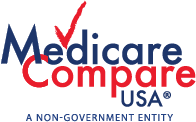Healthcare leaders across the country now have a fresh insight into their marketplace’s competitive landscape and greater clarity as to the health insurance purchasing decision of local Medicare recipients thanks to a new user-friendly data tool created by MedicareCompareUSA. The information is available free of charge to hospitals, health systems and physician organizations and can be accessed at medicarecompareusa.com/providers.
In February the company introduced its popular and industry-leading mapping capability that displayed market penetration of Medicare Advantage plans by county in all 50 states, both in raw numbers and share of market. Now that report has been updated with the most current (April) data and augmented with Medicare Supplement enrollment data by state and insurer, including trends that have emerged county by county relative to senior enrollment. With this complete information in hand, healthcare executives now have a comprehensive picture of what their local population is purchasing relative to health insurance as well as shifts in local market share for Medicare Advantage and Medicare Supplement plans.
Approximately 50 percent of Medicare-eligible patients purchase their own insurance with the balance either dual eligible (receiving both Medicare and Medicaid) or still covered under an employer plan. Given current trends such as the consolidations of health plans into mega-carriers, insurers purchasing physician groups, and the introduction of unique benefits by health plans trying to achieve product differentiation, providers have a greater interest than ever in knowing the market share penetration of plans in their community as well as current growth trends and shifting demographics. Plans don’t typically provide this information to the hospitals, but now through MedicareCompareUSA it is easily available.
“This knowledge is essential in anticipating stability in a given market and the potential impact of changing a provider’s Medicare insurer contractual relationships as well as seeing where the greatest opportunities may exist for risk and shared savings, insurer partnership and plan sponsorship,” said Paul Gauthier, founder and CEO of MedicareCompareUSA. “For healthcare providers that are strategically aligning themselves with specific MA plans or participating in a Medicare ACO, this information is especially important to measure the plans receptivity and changes in the marketplace.”
Gauthier says that the bombardment of sales materials that “new seniors” aging into Medicare receive from competing Medicare Advantage and Supplement plans is a clear indication that hospitals and physicians can no longer sit passively on the sidelines and assume that their patient portfolio is secure. “Now, more than ever, providers need a proactive strategy for managing their Medicare population; and that begins with having current and trusted data. For those providers who have already adopted a Medicare strategy, our new tools are a great way to validate and see if they are focusing on the right areas. For those who have not yet adopted a Medicare strategy, our data is a great starting point to make intelligent and well-informed business decisions.”
Providers can get assistance in this effort through MCUSA Consulting, which can perform a personalized and customized patient insurance demographic analysis for a hospital, health system or medical group. This analysis can help a provider determine its own Medicare Advantage market share on a county level, supply an even deeper insight on local Medicare Supplement carriers and help deliver the intelligence that is needed to drive an effective Medicare initiative. More information on this can be obtained by contacting Kerri Lenderman at kerri.lenderman@mcusaconsulting.com.
The Medicare enrollment data is just one of many tools offered on the MedicareCompareUSA website to consumers, providers and insurance agents. For consumers, the site serves as a Medicare plan enrollment center by providing those on Medicare a one-stop shop to answer questions regarding Medicare options and connect with an agent who can help them enroll in the plan of their choice. For agents, brokers and providers, the site serves as an import resource in helping these audiences realign their strategies and adapt to the changing buying habits of patients. The site is also a vital resource to hospitals at the time of a “compelling event”—such as change in health plan contracts—in helping them retain desirable market share they have worked hard to build.



